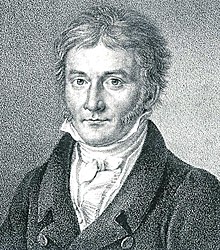| gauss | |
|---|---|
| Unit system | Gaussian and emu-cgs |
| Unit of | magnetic flux density (also known as magnetic induction, or the B-field, or magnetic field) |
| Symbol | G or Gs |
| Named after | Carl Friedrich Gauss |
| Conversions | |
| 1 G or Gs in ... | ... is equal to ... |
| SI derived units | 10 tesla |
| Gaussian base units | 1 cm⋅ |
| esu-cgs | 1/ccgs esu |

The gauss (symbol: G, sometimes Gs) is a unit of measurement of magnetic induction, also known as magnetic flux density. The unit is part of the Gaussian system of units, which inherited it from the older centimetre–gram–second electromagnetic units (CGS-EMU) system. It was named after the German mathematician and physicist Carl Friedrich Gauss in 1936. One gauss is defined as one maxwell per square centimetre.
As the centimetre–gram–second system of units (cgs system) has been superseded by the International System of Units (SI), the use of the gauss has been deprecated by the standards bodies, but is still regularly used in various subfields of science. The SI unit for magnetic flux density is the tesla (symbol T), which corresponds to 10,000gauss.
Name, symbol, and metric prefixes
Albeit not a component of the International System of Units, the usage of the gauss generally follows the rules for SI units. Since the name is derived from a person's name, its symbol is the uppercase letter "G". When the unit is spelled out, it is written in lowercase ("gauss"), unless it begins a sentence. The gauss may be combined with metric prefixes, such as in milligauss, mG (or mGs), or kilogauss, kG (or kGs).
Unit conversions
The gauss is the unit of magnetic flux density B in the system of Gaussian units and is equal to Mx/cm or g/Bi/s, while the oersted is the unit of H-field. One tesla (T) corresponds to 10 gauss, and one ampere (A) per metre corresponds to 4π × 10 oersted.
The units for magnetic flux Φ, which is the integral of magnetic B-field over an area, are the weber (Wb) in the SI and the maxwell (Mx) in the CGS-Gaussian system. The conversion factor is 10 maxwell per weber, since flux is the integral of field over an area, area having the units of the square of distance, thus 10 G/T (magnetic field conversion factor) times the square of 10 cm/m (linear distance conversion factor). 10 Mx/Wb = 10 G/T × (10 cm/m).
Typical values
Main article: Orders of magnitude (magnetic field)- 10–10 G – the magnetic field of the human brain
- 10–10 G – the magnetic field of Galactic molecular clouds. Typical magnetic field strengths within the interstellar medium of the Milky Way are ~5 μG.
- 0.25–0.60 G – the Earth's magnetic field at its surface
- 4 G – near Jupiter's equator
- 25 G – the Earth's magnetic field in its core
- 50 G – a typical refrigerator magnet
- 100 G – an iron magnet
- 1500 G – within a sun spot
- 10000 to 13000 G – remanence of a neodymium-iron-boron (NIB) magnet
- 16000 to 22000 G – saturation of high permeability iron alloys used in transformers
- 3000–70000 G – a medical magnetic resonance imaging machine
- 10–10 G – the surface of a neutron star
- 4 × 10 G – the Schwinger limit
- 10 G – the magnetic field of SGR J1745-2900, orbiting the supermassive black hole Sgr A* in the center of the Milky Way.
- 10 G – the magnetic field of some newly created magnetars
- 10 G – the upper limit to neutron star magnetism
See also
Notes
- The electromagnetic Gaussian and SI quantities correspond (symbol '≘') rather than being equal (symbol '=').
- ccgs = 2.99792458×10 is the numeric part of the speed of light when expressed in cgs units.
References
- NIST Special Publication 1038, Section 4.3.1
- The International System of Units (PDF) (9th ed.), International Bureau of Weights and Measures, Dec 2022, ISBN 978-92-822-2272-0
- International Bureau of Weights and Measures (2006), The International System of Units (SI) (PDF) (8th ed.), ISBN 92-822-2213-6, archived (PDF) from the original on 2021-06-04, retrieved 2021-12-16
- Buffett, Bruce A. (2010), "Tidal dissipation and the strength of the Earth's internal magnetic field", Nature, volume 468, pages 952–954, doi:10.1038/nature09643
- Hoadley, Rick. "How strong are magnets?". www.coolmagnetman.com. Retrieved 2017-01-26.
- Pyrhönen, Juha; Jokinen, Tapani; Hrabovcová, Valéria (2009). Design of Rotating Electrical Machines. John Wiley and Sons. p. 232. ISBN 978-0-470-69516-6.
- Laughton, Michael A.; Warne, Douglas F., eds. (2003). "8". Electrical Engineer's Reference Book (Sixteenth ed.). Newnes. ISBN 0-7506-4637-3.
- "How strong are magnets?". Experiments with magnets and our surroundings. Magcraft. Retrieved 2007-12-14.
- ^ Duncan, Robert C. (March 2003). "Magnetars, Soft Gamma Repeaters and Very Strong Magnetic Fields". University of Texas at Austin. Archived from the original on 2007-06-11. Retrieved 2007-05-23.
| CGS units | |
|---|---|
| Base units | |
| Derived non EM units | |
| Derived EMU units | |
| Derived ESU units | |
